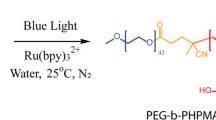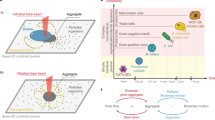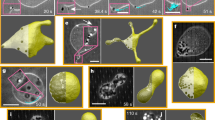Abstract
Dissipative self-assembly is exploited by nature to control important biological functions, such as cell division, motility and signal transduction. The ability to construct synthetic supramolecular assemblies that require the continuous consumption of energy to remain in the functional state is an essential premise for the design of synthetic systems with lifelike properties. Here, we show a new strategy for the dissipative self-assembly of functional supramolecular structures with high structural complexity. It relies on the transient stabilization of vesicles through noncovalent interactions between the surfactants and adenosine triphosphate (ATP), which acts as the chemical fuel. It is shown that the lifetime of the vesicles can be regulated by controlling the hydrolysis rate of ATP. The vesicles sustain a chemical reaction but only as long as chemical fuel is present to keep the system in the out-of-equilibrium state. The lifetime of the vesicles determines the amount of reaction product produced by the system.
This is a preview of subscription content, access via your institution
Access options
Subscribe to this journal
Receive 12 print issues and online access
$259.00 per year
only $21.58 per issue
Buy this article
- Purchase on Springer Link
- Instant access to full article PDF
Prices may be subject to local taxes which are calculated during checkout



Similar content being viewed by others
References
Kushner, D. J. Self-assembly of biological structures. Bacteriol. Rev. 33, 302–245 (1969).
Gale, P. A. & Steed, J. W. (eds) Self-assembly and Supramolecular Devices (Supramolecular Chemistry: From Molecules to Nanomaterials Vol. 5, Wiley, 2012).
Mattia, E. & Otto, S. Supramolecular systems chemistry. Nature Nanotech. 10, 111–119 (2015).
Karsenti, E. Self-organization in cell biology: a brief history. Nature Rev. Mol. Cell Biol. 9, 255–262 (2008).
Whitesides, G. M. & Ismagilov, R. F. Complexity in chemistry. Science 284, 89–92 (1999).
Fialkowski, M. et al. Principles and implementations of dissipative (dynamic) self-assembly. J. Phys. Chem. B 110, 2482–2496 (2006).
Desai, A. & Mitchison, T. J. Microtubule polymerization dynamics. Annu. Rev. Cell Dev. Biol. 13, 83–117 (1997).
Howard, J. Mechanics of Motor Proteins and the Cytoskeleton (Sinauer Associates, 2001).
Rizzoli, S. O. Synaptic vesicle recycling: steps and principles. EMBO J. 33, 788–822 (2014).
Fletcher, S. P., Dumur, F., Pollard, M. M. & Feringa, B. L. A reversible, unidirectional molecular rotary motor driven by chemical energy. Science 310, 80–82 (2005).
Ragazzon, G., Baroncini, M., Silvi, S., Venturi, M. & Credi, A. Light-powered autonomous and directional molecular motion of a dissipative self-assembling system. Nature Nanotech. 10, 70–75 (2015).
Cheng, C. et al. Energetically demanding transport in a supramolecular assembly. J. Am. Chem. Soc. 136, 14702–14705 (2014).
Cheng, C. et al. An artificial molecular pump. Nature Nanotech. 10, 547–553 (2015).
Dambenieks, A. K., Vu, P. H. Q. & Fyles, T. M. Dissipative assembly of a membrane transport system. Chem. Sci. 5, 3396–3403 (2014).
Krabbenborg, S. O., Veerbeek, J. & Huskens, J. Spatially controlled out-of-equilibrium host–guest system under electrochemical control. Chem. Eur. J. 21, 9638–9644 (2015).
Boekhoven, J. et al. Dissipative self-assembly of a molecular gelator by using a chemical fuel. Angew. Chem. Int. Ed. 49, 4825–4828 (2010).
Boekhoven, J., Hendriksen, W. E., Koper, G. J. M., Eelkema, R. & van Esch, J. H. Transient assembly of active materials fueled by a chemical reaction. Science 349, 1075–1079 (2015).
Debnath, S., Roy, S. & Ulijn, R. V. Peptide nanofibers with dynamic instability through nonequilibrium biocatalytic assembly. J. Am. Chem. Soc. 135, 16789–16792 (2013).
Pappas, C. G., Sasselli, I. R. & Ulijn, R. V. Biocatalytic pathway selection in transient tripeptide nanostructures. Angew. Chem. Int. Ed. 54, 8119–8123 (2015).
Aida, T., Meijer, E. W. & Stupp, S. I. Functional supramolecular polymers. Science 335, 813–817 (2012).
Warren, S. C., Guney-Altay, O. & Grzybowski, B. A. Responsive and nonequilibrium nanomaterials. J. Phys. Chem. Lett. 3, 2103–2111 (2012).
Pezzato, C. & Prins, L. J. Transient signal generation in a self-assembled nanosystem fueled by ATP. Nature Commun. 6, 7790 (2015).
Sasaki, R. & Murata, S. Aggregation of amphiphilic pyranines in water: facile micelle formation in the presence of methylviologen. Langmuir 24, 2387–2394 (2008).
Koestereli, Z. & Severin, K. Fluorescence sensing of spermine with a frustrated amphiphile. Chem. Commun. 48, 5841–5843 (2012).
Li, G., Zhang, S., Wu, N., Cheng, Y. & You, J. Spontaneous counterion-induced vesicle formation: multivalent binding to europium(III) for a wide-range optical pH sensor. Adv. Funct. Mater. 24, 6204–6209 (2014).
Prins, L. J. Emergence of complex chemistry on an organic monolayer. Acc. Chem. Res. 48, 1920–1928 (2015).
Cruz-Campa, I. et al. A novel class of metal-directed supramolecular DNA-delivery systems. Chem. Commun. 2944–2946 (2007).
Heuser, T., Steppert, A.-K., Molano Lopez, C., Zhu, B. & Walther, A. Generic concept to program the time domain of self-assemblies with a self-regulation mechanism. Nano Lett. 15, 2213–2219 (2015).
Walde, P., Umakoshi, H., Stano, P. & Mavelli, F. Emergent properties arising from the assembly of amphiphiles. Artificial vesicle membranes as reaction promoters and regulators. Chem. Commun. 50, 10177–10197 (2014).
Galinier, F., Bertorelle, F. & Fery-Forgues, S. Spectrophotometric study of the incorporation of NBD probes in micelles: is a long alkyl chain on the fluorophore an advantage? C.R. Acad. Sci. Chim. 4, 941–950 (2001).
Zhang, X. C., Jackson, J. K. & Burt, H. M. Determination of surfactant critical micelle concentration by a novel fluorescence depolarization technique. J. Biochem. Biophys. Methods 31, 145–150 (1996).
Yu, L., Zhang, H. & Ding, J. D. A subtle end-group effect on macroscopic physical gelation of triblock copolymer aqueous solutions. Angew. Chem. Int. Ed. 45, 2232–2235 (2006).
Ryabov, Y. E., Geraghty, C., Varshney, A. & Fushman, D. An efficient computational method for predicting rotational diffusion tensors of globular proteins using an ellipsoid representation. J. Am. Chem. Soc. 128, 15432–15444 (2006).
Chattoraj, S., Chowdhury, R., Ghosh, S. & Bhattacharyya, K. Heterogeneity in binary mixtures of dimethyl sulfoxide and glycerol: fluorescence correlation spectroscopy. J. Chem. Phys. 138, 214507 (2013).
Acknowledgements
This work was financially supported by the European Commission (grant MSCA 657486 to S.M.), COST Action CM1304 (to L.J.P.), the University of Padova (grant CPDA138148 to L.J.P.) and the Italian Ministry of Education and Research (grant PRIN2010C4R8M8 to C.F.). Full data are provided in the Supplementary Information. ESEM measurements were performed by C. Furlan at the CE.A.S.C. at the University of Padova. CryoTEM measurements were performed by E. Paccagnini in the Electron Microscopy Laboratory of the Department of Life Sciences at the University of Siena (director, P. Lupetti). The authors thank J. Chen for a critical assessment of the manuscript, M. Zerbetto for discussions on the FCS analysis and M. Zangrossi for preparation of the movies.
Author information
Authors and Affiliations
Contributions
S.M. and L.J.P. designed the experiments. S.M. performed all experiments, except for the FCS and confocal microscopy studies, which were performed by I.F. L.J.P. wrote models T, K1 and K2 and performed fitting and simulations. C.F. and P.S. were involved in data interpretation. L.J.P. wrote the manuscript and all authors commented on it.
Corresponding author
Ethics declarations
Competing interests
The authors declare no competing financial interests.
Supplementary information
Supplementary information
Supplementary information (PDF 5605 kb)
Supplementary information
Supplementary movie 1 (MPG 6325 kb)
Supplementary information
Supplementary movie 2 (MPG 4654 kb)
Rights and permissions
About this article
Cite this article
Maiti, S., Fortunati, I., Ferrante, C. et al. Dissipative self-assembly of vesicular nanoreactors. Nature Chem 8, 725–731 (2016). https://doi.org/10.1038/nchem.2511
Received:
Accepted:
Published:
Issue Date:
DOI: https://doi.org/10.1038/nchem.2511
This article is cited by
-
Supramolecular assembly guided by photolytic redox cycling
Nature Synthesis (2023)
-
Mechanosensitive non-equilibrium supramolecular polymerization in closed chemical systems
Nature Communications (2023)
-
Photoswitchable gating of non-equilibrium enzymatic feedback in chemically communicating polymersome nanoreactors
Nature Chemistry (2023)
-
Data-informed discovery of hydrolytic nanozymes
Nature Communications (2022)
-
Switchable aqueous catalytic systems for organic transformations
Communications Chemistry (2022)



